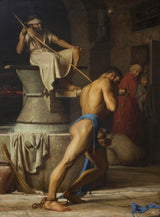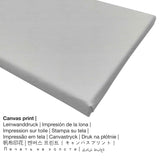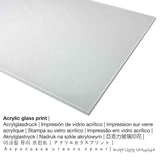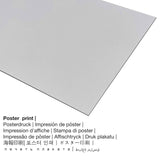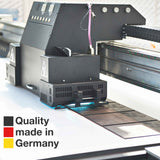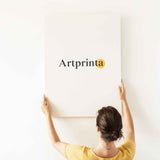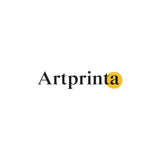Carl Bloch, 1863 - Samson na ndị Filistia - ọmarịcha nka
Ụtụ gụnyere. Mbupu gbakọrọ na ndenye ọpụpụ.
Original artwork description by Statens Museum for Kunst (National Gallery of Denmark) website (© Copyright - Statens Museum for Kunst (National Gallery of Denmark) - Statens Museum maka Kunst (National Gallery nke Denmark))
With Samson and the Philistines, painted in Rome in 1863, Bloch entered the Danish art scene in earnest.
With his virtuoso technique and narrative devices such as the way we as spectators are drawn into the scene, and the sheer concentrated action of the piece he brought Danish art on a par with contemporary European history painting.
The theatrical effects Art history has reproached Bloch for his pronounced use of theatrical effects. Seen in a wider perspective, however, it is remarkable how his aggressive involvement of spectators and setpiece authenticity points ahead towards the aestetics of film where such effects are basic elements.
Just think of the Hollywood studios and D.W. Griffith’s (1875-1948) lavish historical extravaganzas, the theatrical facial expressions and gestures, and the use of close-ups to remove the filters between spectators and objects.
Denmark's greatest painter Samson was followed by several similar pictures, which brought Bloch great recognition, carving him a reputation among his contemporaries as Denmark’s greatest painter. Bloch’s principal work is the series of 23 paintings with scenes from the New Testament that the brewer J.C. Jacobsen (1811-1887) of Carlsberg fame commissioned in 1865 as decorations for King Christian 4.’s (1577-1648) prayer seat in Frederiksborg Chapel.
Ozi ndabere gbasara nka nka izizi
| Aha nka: | "Samsọn na ndị Filistia" |
| Nhazi nka nka: | sere |
| Nhazi nka: | nkà nke oge a |
| Nhazi oge: | 19th narị afọ |
| Emepụtara n'afọ: | 1863 |
| Afọ nka: | 150 afọ |
| Ụlọ ihe ngosi nka: | Statens Museum maka Kunst (National Gallery nke Denmark) |
| Ebe ngosi nka: | Copenhagen, Denmark |
| website: | Statens Museum maka Kunst (National Gallery nke Denmark) |
| Ikikere nke ihe osise: | ngalaba ọha |
| Site n'aka: | National Gallery nke Denmark |
Tebụl nchịkọta ihe nkiri
| aha: | Carl Bloch |
| Aha ndị ọzọ: | Bloch Carl, Bloch Carl Heinrich, Carl Bloch, Carl Heinrich Bloch |
| okike onye nka: | nwoke |
| Nationality: | Danish |
| Ọrụ: | onye na-ese ihe |
| Obodo onye nka: | Denmark |
| Otu nka: | omenkà nke oge a |
| Ụdị nka: | Ihe ngosi |
| Afọ ọnwụ: | 56 afọ |
| Afọ ọmụmụ: | 1834 |
| Obodo ọmụmụ: | Copenhagen, Hovedstaden, Denmark |
| Nwuru: | 1890 |
| Obodo ọnwụ: | Copenhagen |
Ozi ngwaahịa ahaziri
| Bipụta ngwaahịa: | mmepụta nka |
| Usoro mmeghari: | mmeputakwa n'ụdị dijitalụ |
| Usoro nhazi: | UV kpọmkwem obibi |
| Mmalite ngwaahịa: | Germany |
| Stockdị ngwaahịa: | na mmepụta ihe |
| A na-atụ aro iji ngwaahịa eme ihe: | foto mgbidi, nchịkọta nka (mmepụta) |
| Ndozi onyonyo: | nhazi ihe osise |
| Njikwa oyiyi: | ogologo: obosara - 3: 4 |
| Nkọwa nke oke onyonyo a: | ogologo bụ 25% mkpụmkpụ karịa obosara |
| Ụdị ihe dị iche iche dị: | Mpempe akwụkwọ mmado (akwụkwọ kwaaji), mbipụta kanvas, mbipụta ọla (aluminium dibond), mbipụta iko acrylic (nwere ezigbo mkpuchi iko) |
| Nhọrọ nke Canvas Mbipụta (akwa akwa na etiti ihe ndọtị): | 30x40cm - 12x16", 60x80cm - 24x31", 90x120cm - 35x47", 120x160cm - 47x63" |
| Mpempe iko acrylic (nwere ezigbo mkpuchi iko) nha dị iche iche: | 30x40cm - 12x16", 60x80cm - 24x31", 90x120cm - 35x47", 120x160cm - 47x63" |
| Nhọrọ nha nke akwụkwọ mmado (akwụkwọ kwaaji): | 30x40cm - 12x16", 60x80cm - 24x31", 90x120cm - 35x47" |
| Mbipụta nke aluminom (ihe aluminom): | 30x40cm - 12x16", 60x80cm - 24x31", 90x120cm - 35x47" |
| Nhazi mbipụta nka: | biko buru n'uche na edeghị nka nka |
Ngwaahịa ị nwere ike iburu
Maka ngwaahịa ọ bụla anyị na-enye ihe dị iche iche & nha. Anyị na-ahapụ gị ka ịhọrọ nha na akụrụngwa ọkacha mmasị gị n'etiti nhọrọ nhazi ngwaahịa ndị a:
- Mbipụta iko acrylic na-egbuke egbuke: An print on acrylic glass, which is sometimes denoted as a plexiglass print, transforms the original into beautiful décor. Besides, the acrylic print forms a good alternative option to dibond or canvas fine art prints. Your own replica of the artwork is custom-made with the help of modern UV printing technology. This has the image effect of sharp, vivid colors.
- Mpempe akwụkwọ ederede (akwa akwa akwa): The Artprinta poster print is a UV printed flat cotton canvas paper with a slight surface texture, that resembles the original masterpiece. Please note, that depending on the absolute size of the poster print we add a white margin of around 2 - 6cm round about the work of art to facilitate the framing.
- Mbipụta kanvas: The canvas print is a printed canvas mounted on a wooden stretcher. Further, a canvas print generates a lively and comfortable effect. Hanging a canvas print: Canvas prints are relatively low in weight, which means that it is easy to hang your Canvas print without the help of any wall-mounts. Because of thata canvas print is suitable for any type of wall.
- Mbipụta nke aluminom: These are metal prints on aluminium dibond material with a true effect of depth, creating a contemporary impression with a non-reflective surface structure. For your Direct Aluminium Dibond option, we print the selected artwork onto the aluminium white-primed surface. The colors of the print are vivid and luminous in the highest definition, details appear crisp and clear.
Nke a masterpiece Samson and the Philistines onye na-ese ihe mere ya Carl Bloch. Agụnyere ihe osise a na Statens Museum maka Kunst (National Gallery nke Denmark)'s digital collection. We are delighted to reference that this ngalaba ọha A na-enye ihe osise na nkwanye ùgwù nke National Gallery nke Denmark.Kridi n'obi nke artpiece bụ ndị a: . E wezụga nke ahụ, nhazi ahụ dị n'ime Eserese usoro na oke nke 3: 4, nke pụtara na ogologo bụ 25% mkpụmkpụ karịa obosara. The painter Carl Bloch was a European artist from Denmark, whose style can mainly be assigned to Realism. The artist was born in the year 1834 in Copenhagen, Hovedstaden, Denmark and deceased at the age of 56 na 1890.
Ederede iwu dị mkpa: We try what we can in order to depict the art products as precisely as possible and to illustrate them visually in our shop. Please bear in mind that some tone of the printed materials, as well as the print result can differ slightly from the image on your screen. Depending on your settings of your screen and the quality of the surface, color pigments may not be printed as realistically as the digital version depicted here. In view of the fact that all the fine art prints are printed and processed manually, there might also be slight variations in the size and exact position of the motif.
© Nwebiisinka nke - Artprinta (www.artprinta.com)

